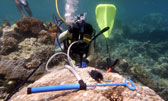




 Scientists & engineers participating in NRF-funded research on peatlands. Clockwise (L-R): Idaly bin Ali, Dr Alex Cobb; Ngo Kang Min & Dr Kai Fuu Ming
Scientists & engineers participating in NRF-funded research on peatlands. Clockwise (L-R): Idaly bin Ali, Dr Alex Cobb; Ngo Kang Min & Dr Kai Fuu Ming
Peatlands are areas where partly decomposed wood from dense swamp forest has built up into soggy mounds of organic matter, or peat, kilometres across and metres thick. Peat accumulates over thousands of years in wet, low-lying areas because waterlogged wood in the peat soil decomposes very slowly.
In their natural state, tropical peatlands are not vulnerable to fire because swampy water flows sluggishly through the peat and is constantly replaced by rain. However, in the last 30 years, 70% of natural peatlands have been deforested and converted for agriculture. The most common economic uses of peatlands require that the peat is drained by digging canals and ditches, allowing rainwater to quickly flow out of the peat. Once it has been drained, dry peat is over 99% combustible.
Unlike ordinary forest fires, peat fires consume the organic soil itself, creating underground, smouldering fires that are very difficult to extinguish.
Singapore has started a collaborative project studying the connection between hydrology and fire in tropical peatlands. For full story in NRF's RIE News eZine, see pictures below.
Or zip to SMART LinkedIn for more. You can also download the January 2019 issue of 'RIE News' for more.